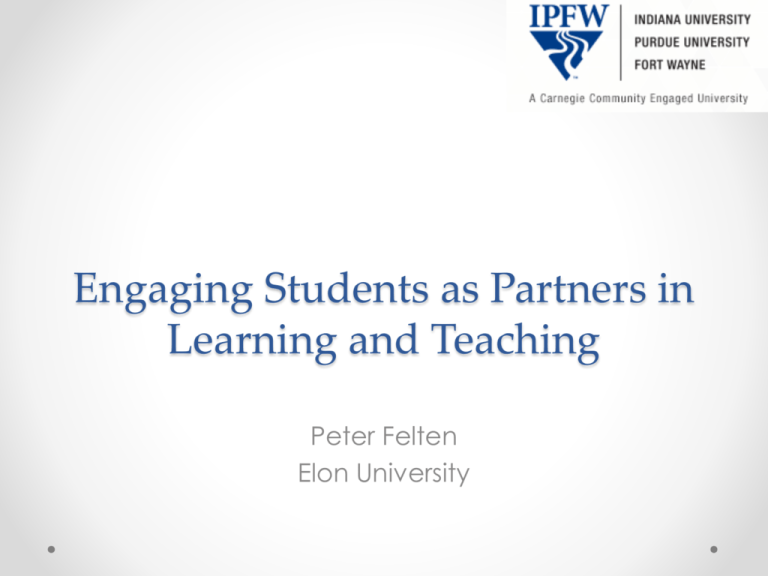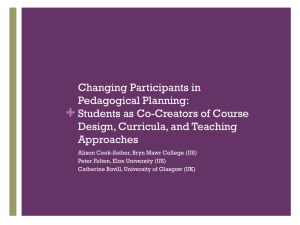Dr. Felten's Presentation
advertisement

Engaging Students as Partners in Learning and Teaching Peter Felten Elon University Describe one of your favorite students. What are some common characteristics of the students you described? Student learning strategies tend to be context-specific, not student-specific. (Biggs & Tang, 2011) Teaching to students Teaching with students Organizing questions 1. What and why? 2. How do you do it? 3. What results? 4. Who, me? Partnership 1. A collaborative, reciprocal process 2. All participants have the opportunity to contribute equally, although not necessarily in the same ways 3. Focusing on practices of and questions about teaching and learning in higher education Designing Responding Assessing Inquiring Premises Respect Reciprocity Responsibility Students have valuable insights about teaching and learning. The customs & structures of schooling make it hard for students to have voice – and for faculty to hear them. Partnership requires 1. 2. 3. 4. Trust and respect Shared power Shared risks Shared learning “open eyes and ears, but also open hearts and minds” (Delpit, 1998) Two student perspectives “Nothing is more powerful than seeing a professor take your ideas seriously.” “When we started working together I felt vulnerable because I had never done anything like that before. I was a little scared of the professor. I was surprised when he told me later that he had felt the same way. We ended up laughing together about that.” Some challenges Expertise Context Time Inclusion Accreditation A faculty perspective “Come in with an open mind about how much you can change your perspective, but do not get hung up on a perceived need for radical change in your pedagogy. One of the most valuable things about this work for me has not necessarily been learning completely new ideas, but rather forcing me to think through, articulate, refine, and put into a stronger framework the techniques I have in place.” Why faculty partner with students • Seeking new insights into student learning • Trying to solve a persistent teaching problem • Enacting democratic values and pedagogies Why students partner with faculty • Curiosity and “honor” • Desire to give back • Tangible rewards Your partnership • What are your goals for a partnership? • Why might one of your favorite students partner with you? Teaching to students Teaching with students Organizing questions 1. What and why? 2. How do you do it? 3. What results? 4. Who, me? A faculty perspective “I think that when most faculty hear about partnership…they assume that it means giving the students unfettered authority or equality in the teaching process. But I realize that taking student contributions seriously DOES NOT mean blindly or directly following their opinions and suggestions, but rather carefully reflecting on and analyzing them, and then addressing the concerns behind them in a way that is consistent with my overall goals and values.” Forms of partnership Designing Responding Assessing Inquiring Designing Responding Max Thomosan, flickr.com Assessing Jen Hegna, www.flickr.com Inquiring Your partnership 1. What are your goals for your partnership? 2. What kind of partnership will you have - designing, responding, assessing, or inquiring? 1. What will you and your student partner(s) do together to reach your goals? 2. Who will your student partners be? Why those particular students? Organizing questions 1. What and why? 2. How do you do it? 3. What results? 4. Who, me? “Students are accustomed to, and often comfortable with, assuming a relatively powerless role in the classroom, just as faculty are trained to believe that their disciplinary expertise gives them complete authority over the learning process. When faculty or students challenge these habits, students and faculty must confront fundamental questions about the nature of teaching and learning.” (Delpish et al., 2010) Results – a faculty journal Week 7: “I don’t think this group project will work. I really should have put my foot down and told them that my way was the only way to do it to ensure that everyone contributed…. Some of them will simply blow it off and the importance of this module will be lost…. Grading this is going to be a nightmare – should I even bother? How will I differentiate between students?... I should not have given this option – it will be a disaster!” Results – a faculty journal Week 11: “The group project went really well…. Because they had worked with each other for two months now, they seemed to be aware of each other’s strengths and weaknesses…. Be sure to have them add a component to their reflections about group dynamics.” What to expect of results? High-Impact Practices 1. 2. 3. 4. 5. 6. 7. 8. High expectations Significant time & effort Meaningful interactions Experiences with diversity Frequent feedback Opportunities for reflection Real-world applications Learning is public (Kuh & O’Donnell, 2013) Faculty inquiry into student learning yields better teaching & deeper student learning. (Hutchings et al, 2011) What results? Engagement – enhancing motivation and learning Awareness – developing metacognitive awareness and identity Enhancement – improving teaching and classroom experiences 1. Engagement - students “Participating in this [partnership] has given me the push I didn’t know I needed back in the direction of hard work and taking college seriously as a learning experience.” “Then one day we happened on the subject of teacher and student responsibilities, and wham! The realization hit me: What were my own responsibilities for my education? It was such an odd question. Why had I not thought of this before?” 1. Engagement - faculty “My student partner did a good job of reconnecting me to the students. She was a bridge back to me being an advocate for the students…. She reminded me of how much I care and made me refocus my attention on helping students as opposed to simply setting up challenges and obstacles that I expected them to meet.” 2. Awareness - student “I am more conscious of my own goals for taking a particular class and the big ideas that come out of individual lessons in the class.” “If I don’t understand something that the professor is explaining, I try to figure out why I don’t understand instead of just writing it down and hoping for the best.” “You really don’t understand the way you learn until you can step back from it and are not in the class with the main aim to learn the material…. Thinking about what and why your classmates are learning changes how you learn.” 2. Awareness - faculty “What you get is looking in a mirror, only better.” Partnering with students “made me conscious of myself [in the classroom] in an unaccustomed and uneasy way.” “I now am better able to point out and articulate (to myself or others) what is and is not working the way I want in a class.” 3. Enhancement - students “I’ve started thinking about ways I can help make the discussions better for everyone in the class, including the professor, instead of just for me.” “When a class isn’t working for me, instead of resigning [myself] to the idea that it’s a bad class, I work to understand why I am having a negative experience and what would need to happen to make it a positive one.” 3. Enhancement - faculty “It felt like the difference between working out on your own, and working out while your coach is observing you to provide feedback: it kept me focused.” “Many of the questions I now ask [about my teaching] I would not have asked were it not for the students’ collaboration with me.” “I have always strived to adjust course content and process to match student interests and needs, but I had always seen that as a process of me adjusting to them. Now I see that as just one part of us working together.” Results for communities 1. Enhanced programs and curricula 2. Culture of “radical collegiality” (Fielding, 1999) Community - students “I was really surprised to realize how much more connected I feel to [the university] now that I have interacted with the community in a new and different way…than a regular student would. I also feel like I have contributed something to the school as well and done my best to help future teachers and learners on campus. I am no longer just a student who takes classes here.” Community - faculty “This was a transformative experience; it reconnected me with my love of and investment in teaching; recharged my understanding of the connections between my classroom, my scholarship, and my work as a member of my college community; and reawakened my faith in the potential academic institutions have to be sites of innovative and vital work for all who are part of the community.” Results of your partnership What would you most like to have result from your partnership? - For your students - For you - For your community Organizing questions 1. What and why? 2. What results? 3. How do you do it? 4. Who, me? Partnership in action 1. Start small and be patient 2. Invite, don’t require 1. Work together to create a shared purpose & project 2. Integrate partnerships into ongoing work 3. Cultivate allies Navigating power 1. Think about your own attitudes toward power 1. Develop ways to negotiate within the partnership 2. Be honest about where power imbalances persist Your partnership 1. What are your goals for a partnership? 2. What are some steps toward that partnership? What will you do, when? 3. How might power complicate your partnership? 4. How can colleagues help your partnership thrive? 5. What questions remain? “Educational innovation today invites, even requires, levels of preparation, imagination, collaboration, and support that are not always a good fit (to say the least) with the inherited routines of academic life.” (Hutchings et al., 2011) “I think some faculty … are so focused on getting stuff done that they don’t pay attention to their students, who I think are the most valuable resources in the classroom.” (Elon undergraduate quoted in Cook-Sather et al., 2014) References Biggs, J., & Tang, C. Teaching for Quality Learning at University, 4th edition (Open University Press, 2011). Cook-Sather, A., Bovill, C., & Felten, P. Engaging Students as Partners in Learning and Teaching (Jossey-Bass, 2014). Delpish, A., et al. “Equalizing Voices.” In C. Werder & M. Otis, eds. Engaging Student Voices in the Study of Teaching and Learning (Stylus, 2010), 96-114. Delpit, L. “The Silenced Dialogue.” Harvard Educational Review 58:3 (1998), 280-298. Fielding, M. “Radical Collegiality.” Australian Educational Researcher 26;2 (1999), 1-34. Hutchings, P., Huber, M., & Ciconne, A. The Scholarship of Teaching and Learning Reconsidered (Jossey-Bass, 2011). Kuh, K., & O’Donnell, K. Ensuring Quality and Taking High Impact Practices to Scale (AAC&U, 2013). Engaging Students as Partners in Learning and Teaching Peter Felten pfelten@elon.edu








